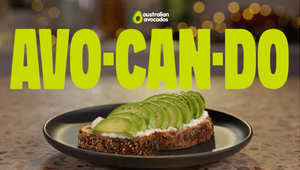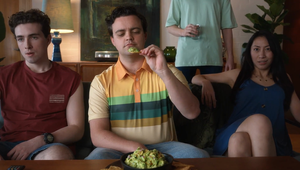
Pushing the Big Red Button for Vodafone: “No Shitty Bits in this Whole Production”

How do you promote a telco doubling its coverage? According to Thinkerbell and Vodafone, all you need is a big red button.
The spot sees Barry, a character based on a real-life Vodafone employee (according to Thinkerbell’s CCO Paul Swann), as he launches the double coverage. What follows is a myriad of playful and imaginative scenarios where Vodafone’s coverage saves the day: from llamas chasing a man, to a phone being buried in a grave. All set tothe 1979 disco hit, ‘Born to be Alive’ by Patrick Hernandez.
LBB’s Casey Martin spoke to Paul about the pressures of working with a beloved Australian brand, the difference between an alpaca and a llama, and how there “were no shitty bits in this whole production.”
LBB> When working on a huge brand such as Vodafone, did you feel an added pressure to get it right?
Paul> We work with clients of all shapes and sizes. We love them all and I’d like to think that we feel the same onus to get it right on any brief that comes our way, but as we started to realise the amount of work that Vodafone had put into doubling their network in terms of time, effort, and investment, I’d be lying if I said it didn’t give us a little extra impetus. The campaign needed to drop at a very specific point in time too, so that also sharpened our focus.
The Vodafone team were clear from the outset with regards to the importance of the project to their business and they were precise in the information they shared and feedback they gave but equally they cultivated a sense of creative freedom and fun along the way which meant that we never felt stifled by the scale of the task and that looming deadline.
LBB> The campaign is like a shot of espresso for the brand, it feels fresh. What was the process like to get to the final product?
Paul> Once it’s clear what you want to communicate, you can start to have a lot of fun. We didn’t want to deviate from the core message of ‘Vodafone now has double coverage’, and staying really close to this means we could then dramatise it in unexpected and lateral ways.
Once we had determined the messaging and devised the broad structure of the film assets, we set about trying to come up with better, more humourous vignettes that landed this message in the most succinct way possible. It was a bit of a writers room mentality and a really enjoyable part of the process.
Something we thought carefully about throughout was the pacing; we wanted it to have a really upbeat energy, which influenced lots of decisions we made, from the scenarios, to the editing, and of course the music selection.
The Scoundrel team came onboard early in the process and were extremely collaborative and flexible. They took the time to understand the brand, its tone, and even the realities of what it meant for Vodafone to double its network. This helped make the process super smooth. I know it’s an enormous cliche, but it really did feel like one team all pulling in the same direction, in fact we were all genuinely sad to see the project end.
As for the llamas, they were a great addition, their ability to be both cute and slightly menacing at the same time was very much part of the appeal.
LBB> Vodafone has been one of the quieter telcos in Australia recently from an advertising perspective. How did you use creativity to enhance the brand?
Paul> Vodafone is a massive brand with a broad customer base, so we knew we needed to create something with mass appeal and clarity of takeout. We started by thinking about use cases for the increased coverage that everyone one could relate to and then we heightened the jeopardy or absurdity to create the engagement and humour. The frenetic nature of these scenes was in stark contrast to the HQ scenes which had an understated composure.
The Vodafone brand also has a strong heritage with younger consumers and in the music space so these became important too. The team really sweated the styling and the music search was extensive to say the least. In terms of the music track we selected (Patrick Hernandez’s 1979 disco hit ‘Born to be Alive’), it has the right vibe, is familiar to older people, and has a sense of discovery for younger people. It fits nicely.
LBB> What did you learn?
Paul> We learned quite a bit about how network coverage actually works and specifically that doubling a mobile network is a vast and complex technical undertaking, but it’s ultimately initiated by someone pressing a button on a computer in a relatively nondescript room.
The difference between a llama and an alpaca (alpacas are very gentle and shy, while llamas are confident and brave).
Madonna was briefly a back-up dancer for Patrick Hernandez.
Vodafone has doubled its network coverage.
LBB> What were the challenges and highlights?
Paul> I alluded to this earlier, but the collaboration between everyone involved was a real highlight. There was a great openness to everyone's ideas and input. This was a high stakes project but everyone kept their cool when we encountered curveballs. It’s enjoyable moving fast when everyone’s moving in the same direction - it’s where creativity builds momentum.
Another highlight has been how well the concept has worked in the myriad of formats that it needs to live in. The structure of the execution means that the 6” and 15” land just as well as the longer formats. These shorter formats are often the bulk of the media buy, so need to be front of mind from the outset.
LBB> What surprised you the most?
Paul> There were no shitty bits in this whole production, from insight to idea to execution, it’s been lovely. Seriously. Surely that’s a little surprising?
LBB> What has been the response so far?
Paul> Early reports are good. Lisa Cronin (head of brand strategy) has received a lot of positive feedback from those within Vodafone and the industry, I think it’s fair to say that it’s gone down quite well.
We’ve also had very positive feedback from consumers and even some nice emails from competitive agencies - which is always appreciated.
Oh and the main male protagonist, Barry, is based on a real Vodafone employee, who shares the same name. We’re told that he’s a fan too.















